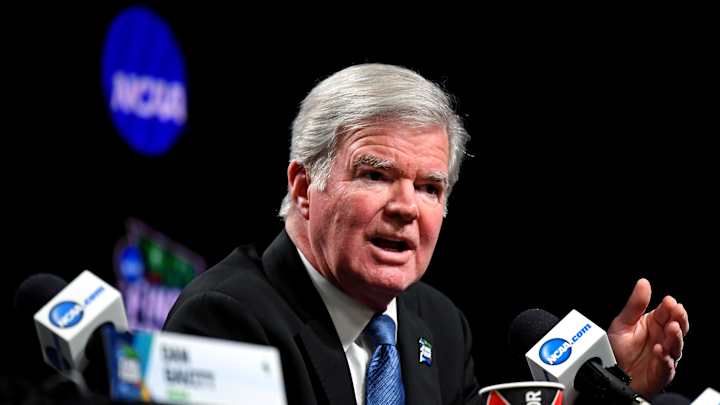Hoops Recruits Say NIL Approval Makes College More Attractive

As a consensus top 10 prospect in the 2022 class, Dariq Whitehead is acutely aware of every aspect of his recruitment.
From studying depth charts of prospective schools to potential coaching changes, the 6-foot-6 wing and his inner circle are well-versed on the nuances of the recruiting game.
Makes sense for a player who leans heavy toward the college route, despite the multiple pro-options he’ll be afforded as a result of his top tier status.
RELATED: New era of college sports is here: is anyone ready?
“For now, I’m just thinking college,” Whitehead said. “My family and I are really big on education because you just never know with sports. You need something after basketball. The big thing about the pro-option is the money.”
RELATED: Congress Making Progress on NIL Rights
In May, NCAA president Mark Emmert countered that point with a chess move of his own, recommending the approval of name, image and likeness (NIL) rights "before, or as close to, July 1," according to the New York Times.
As of Thursday, July 1, all NCAA athletes will be able profit from their NIL after the governing bodies from all three NCAA divisions voted to approve the interim NIL policy Wednesday.
Still, elite players remain puzzled about how the ruling took so long.
“I’ve always felt that players should definitely be able to profit on their image and likeness,” Whitehead said. “I’ve never understood why they can’t. I mean if the school can profit, why can’t we? So, yeah, this news of college moving in that direction definitely makes the college option even more attractive.” .
College athletes must still abide by NIL rules in their specific states, but can now profit from sponsorships and endorsements.
The NCAA passed a rule to permit individual schools who reside in states without a law to create their own compensation rules.
Congress is working toward a critical agreement on a federal NIL bill for college athletes.
RELATED: Southern JamFest Players to Watch
“The NCAA tournament a lone brings more than $1 billion annually,” said Kwame Evans Jr., a consensus top 10 prospect in the 2023 class. “Yet, the players who provide the product from which everyone else profits receive no piece of the pie. Don’t get me wrong, the platform, the scholarships and everything else are very much appreciated and has the potential to change lives. However, there needs to be real change.”
The interim NIL approval allows college athletes to rack up advertisement money through their social media accounts; a potential gold mine for top tier players destined for the NBA.
Team Final (Penn.) Jalen Duren fits that mold.
A 6-10, 230-pound slab of teen, Duren is already widely regarded as a top three pick in the 2023 NBA Draft, and is considering G League and overseas options along with top colleges like Kentucky, Miami, Memphis and others.
“College has always been the main option for me,” Duren said. “That whole aspect of the NIL makes it an even stronger option though. That’s something I think we all agree on.”
Whitehead said he leans on his older brother Tahir Whitehead, a 10-year NFL veteran linebacker who currently plays for the Carolina Panthers, to keep him in a business mindset as it pertains to his career.
“He talks to me about a lot of opportunities and avenues to make money from your name,” Dariq said. “He’s lived in that world for a long time, so he knows every aspect of that. He’s a great resource for me with everything about to change.”
The NCAA was scheduled to vote on a NIL rights proposal in January before voting to indefinitely postpone it.
The timing of the approval is understandable as more players legitimately entertain pro options post-high school.
Last year, five high school players opted for the NBA G League rather than suiting up in college. This year, three high school players have already committed to the G League, and six elite juniors have committed to the newly formed Overtime Elite pro league, which is set to launch in September.
Last month, Michael Foster, an SI All-American forward, opted for the G League over Florida State and Georgia, referring to the pro route as “the golden path.”
“I don’t feel like I’m missing anything developmentally by missing college,” Foster said. “I would feel that way if I wasn’t going pro. There are just so many opportunities that you miss out on by going to college. It’s a whole new world as a pro.”
SIAA First Team | SIAA Second Team | SIAA Third Team
Foster’s perspective makes even more sense when you consider that he’s making his acting debut alongside Adam Sandler and Queen Latifah this fall in the movie “Hustle.”
“Those are the opportunities you can pursue as a pro,” Foster said. “It’s just a whole new world.”
Still, Hollywood aside, the general consensus among elite players is that approving NIL rights is a major step in the right direction for the NCAA to keep top talent on college campuses.
“I feel like these days the smart thing to do is to keep all of your options open,” said MJ Rice, a consensus top-15 player in the 2022 class. “It’s not like it was five years ago when no one really thought about anything but college. But the NIL rights are big. Most players lean college a little anyway, so to have this is big for college basketball.”
